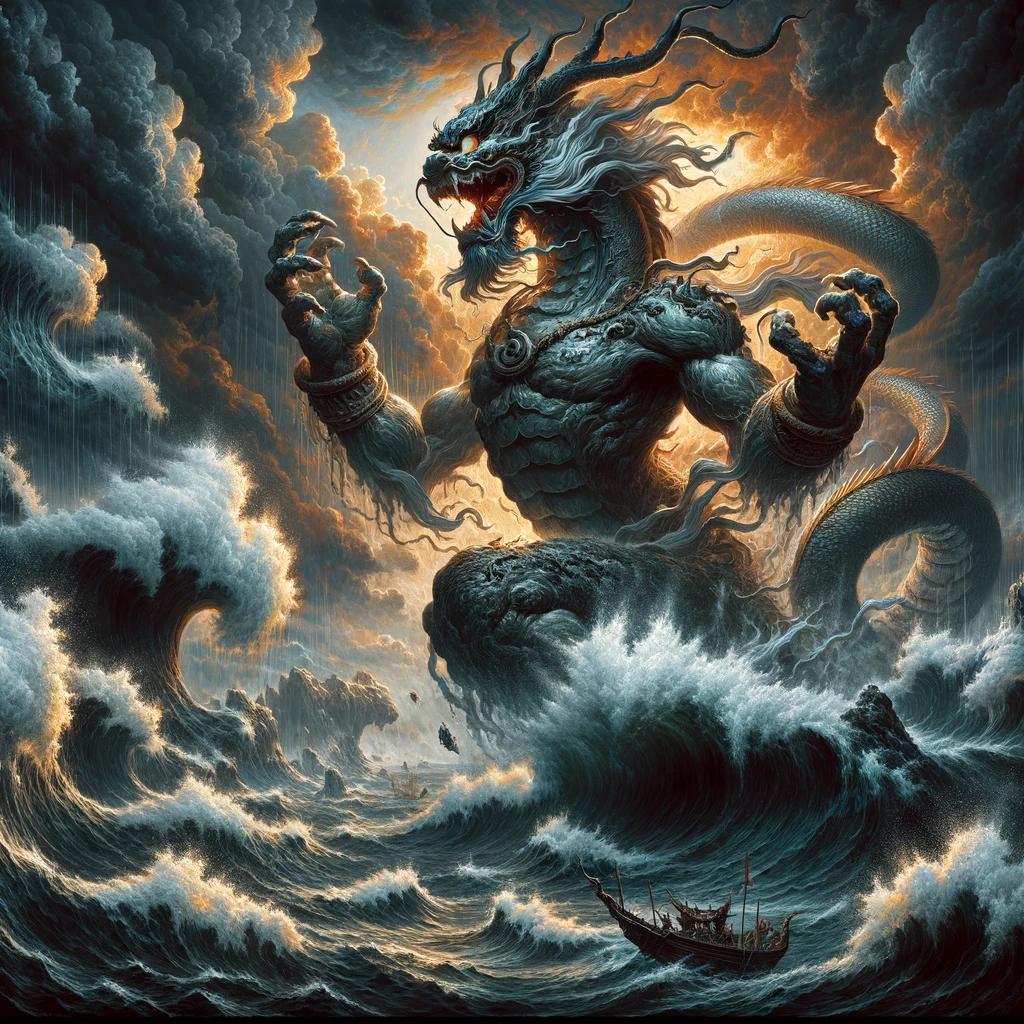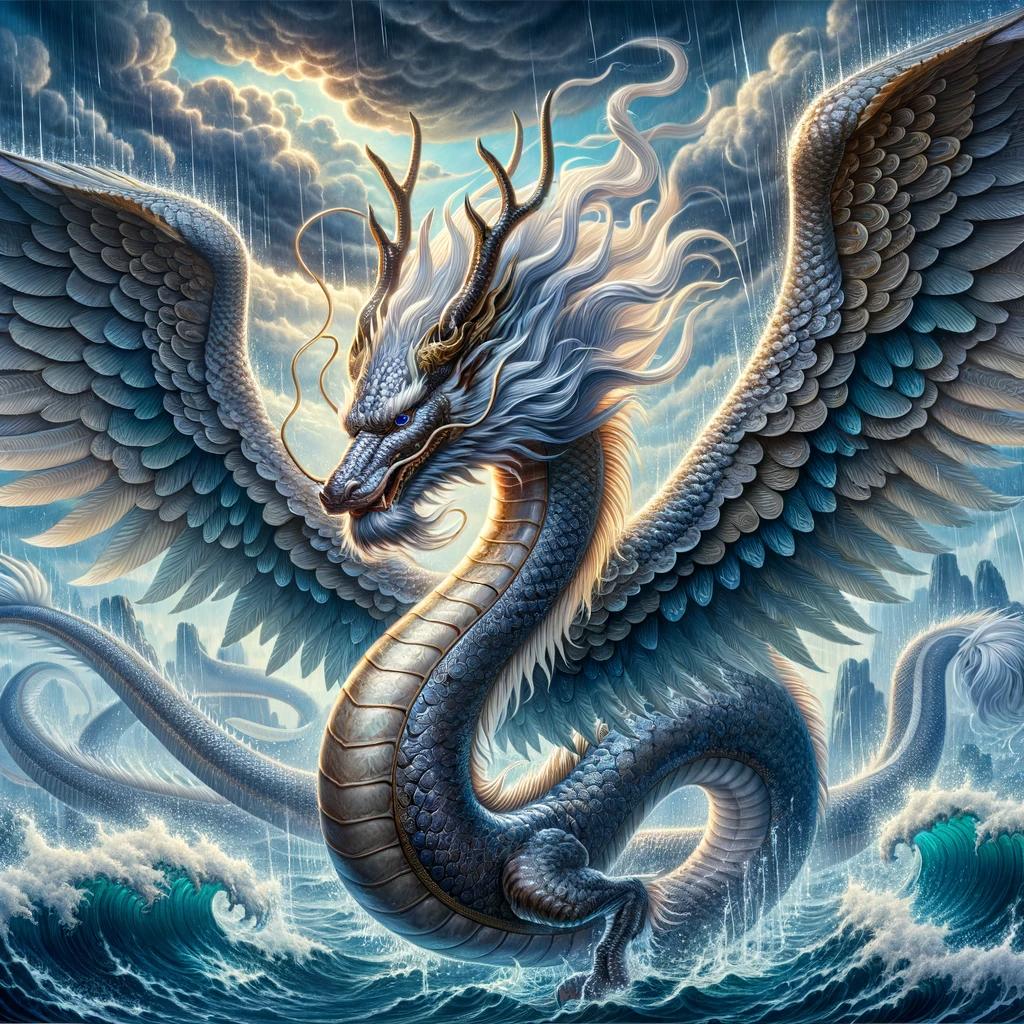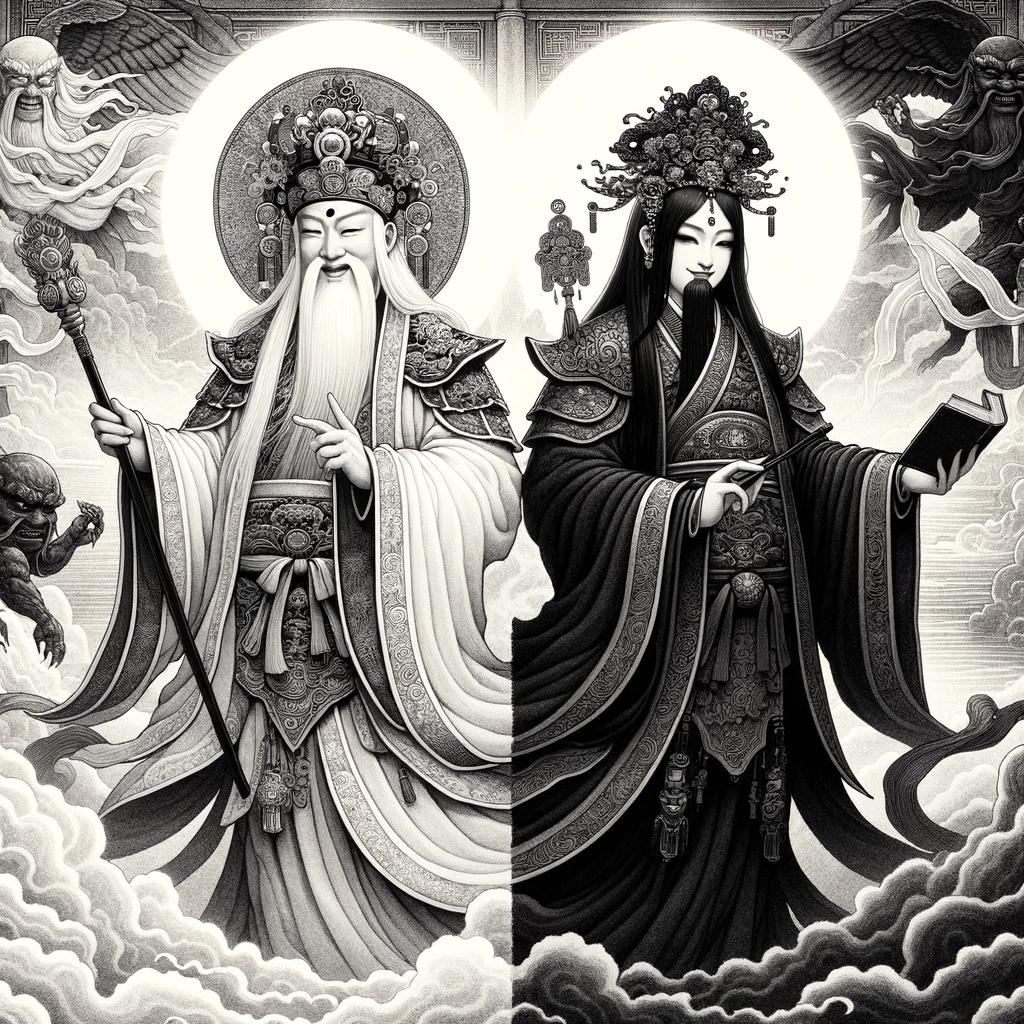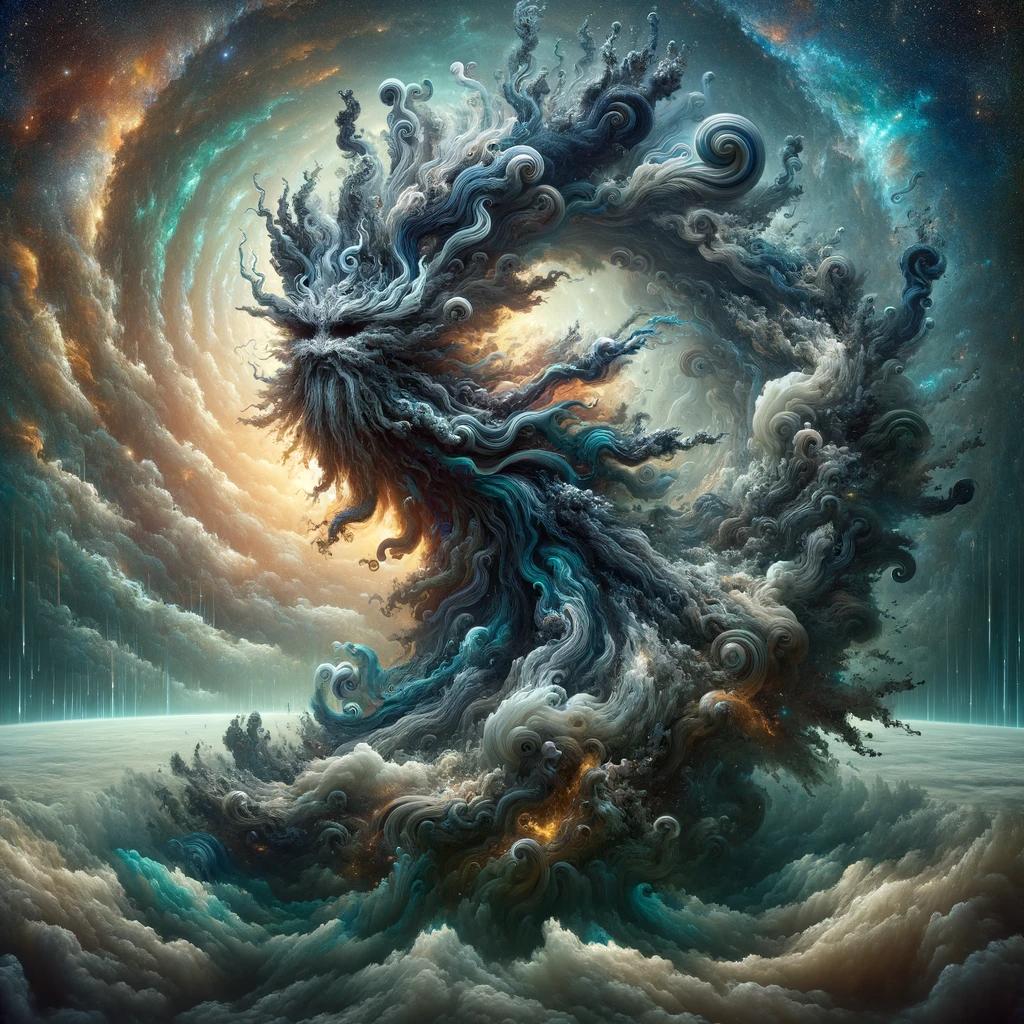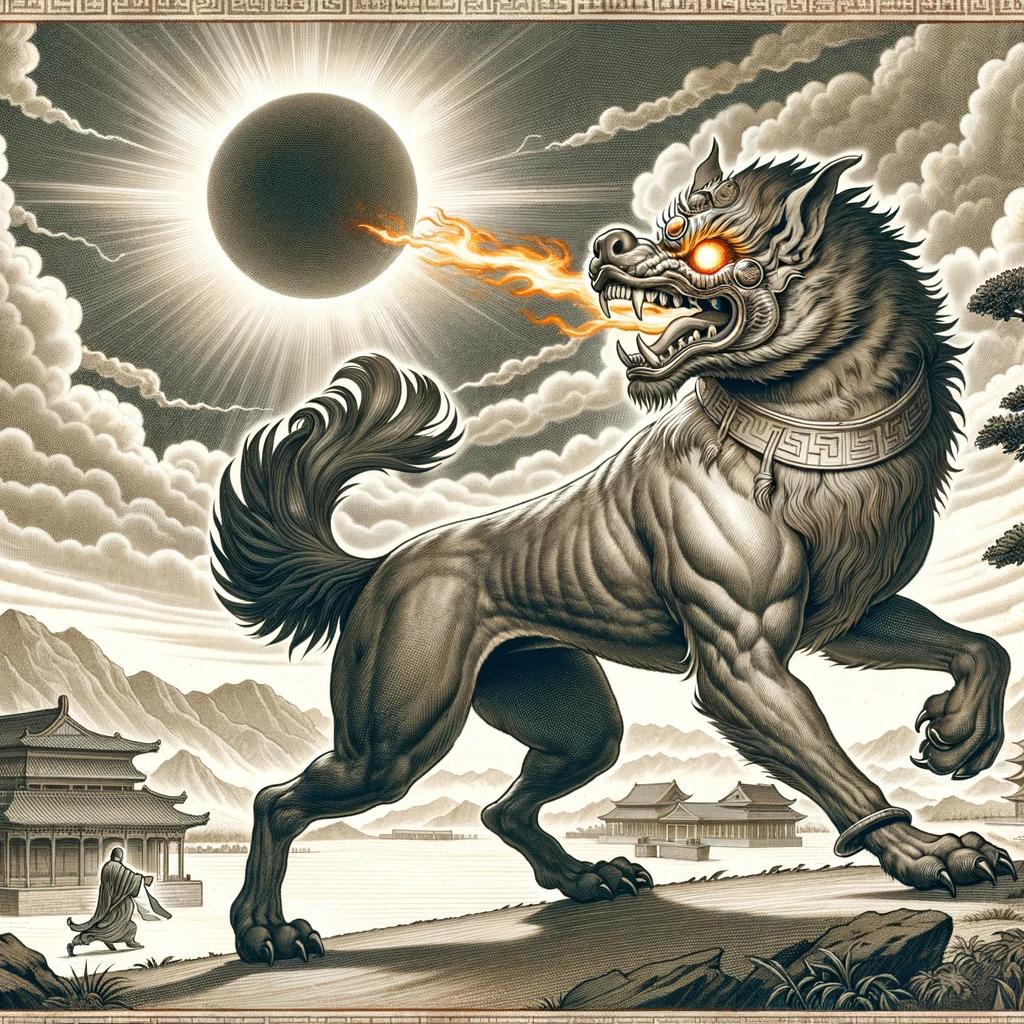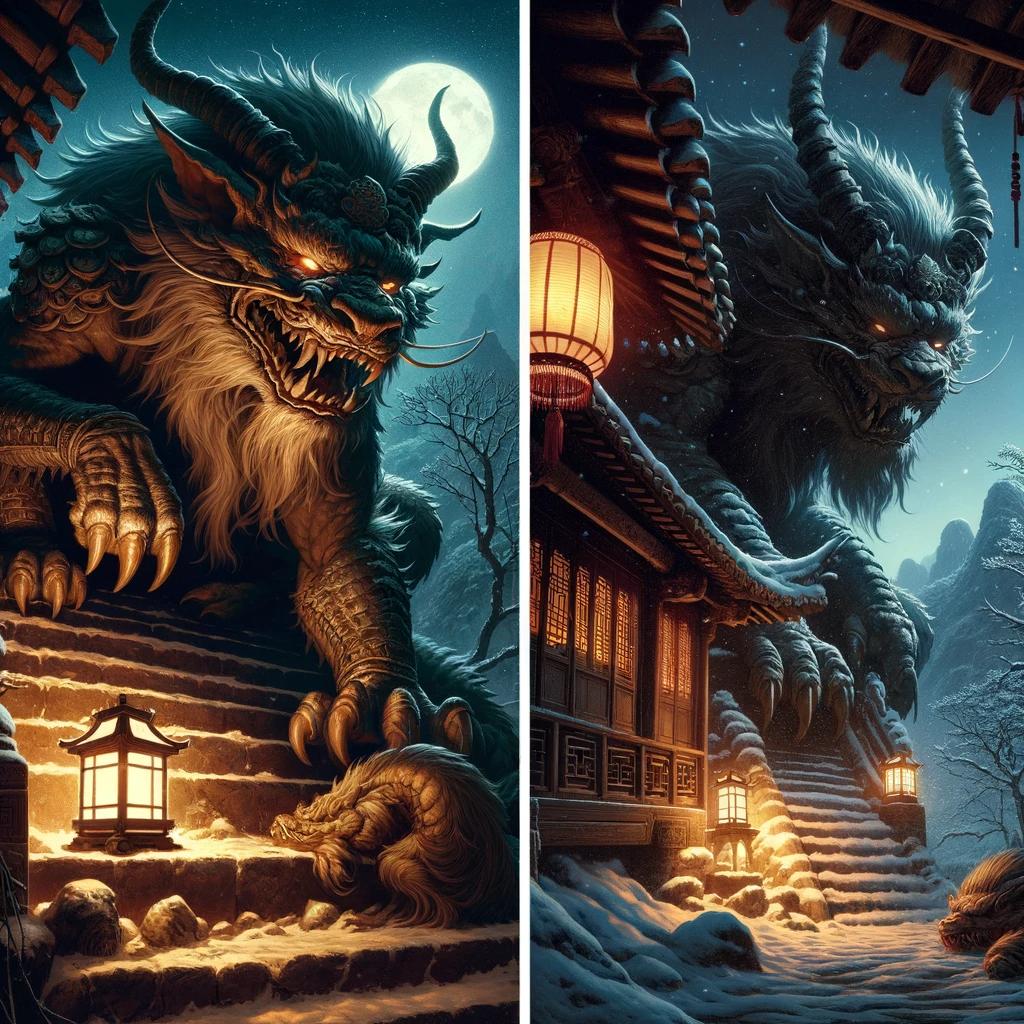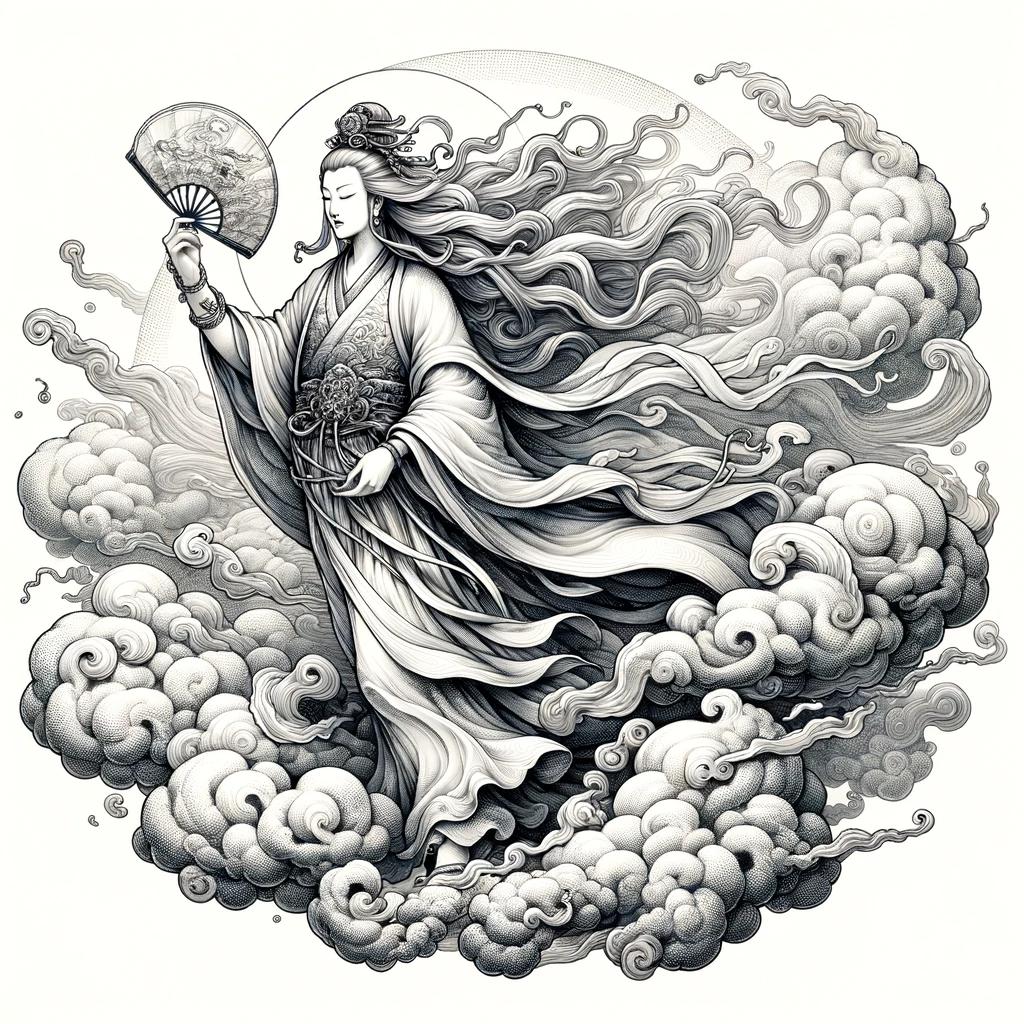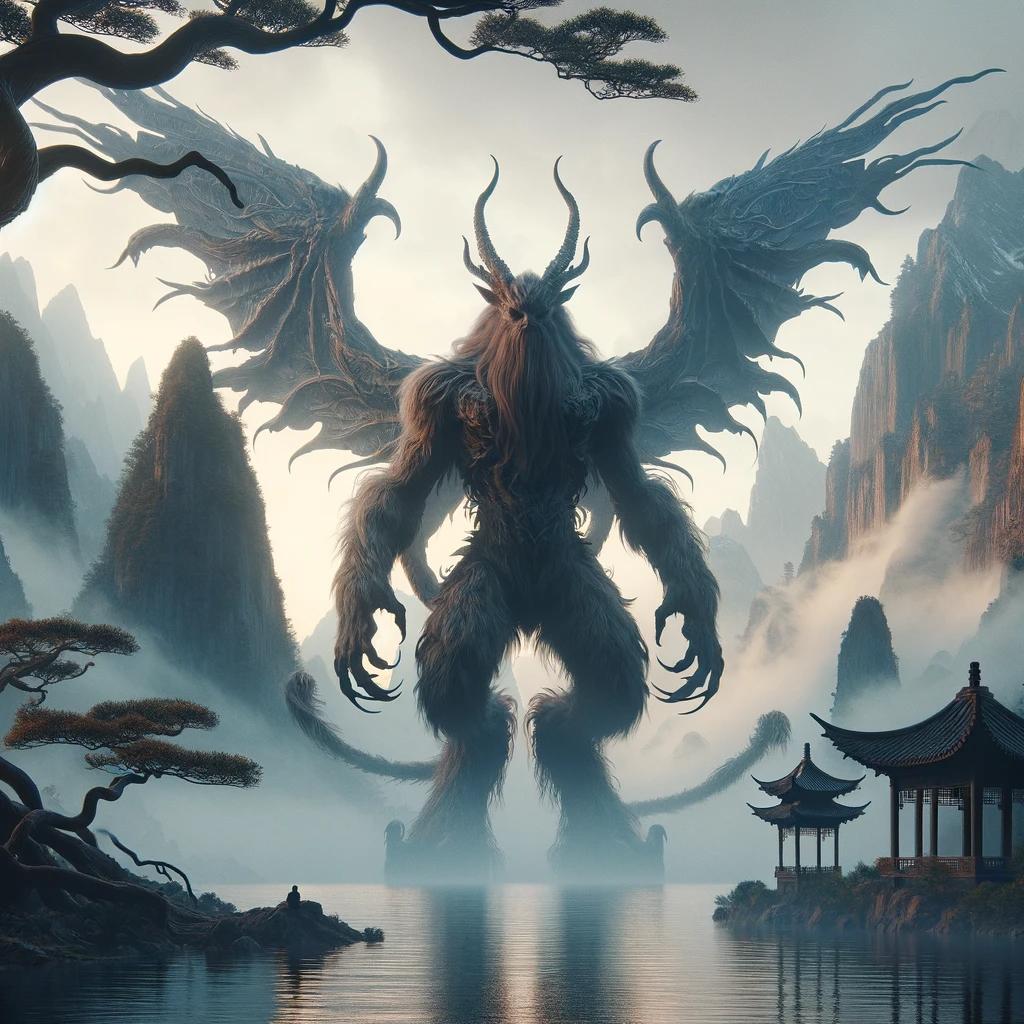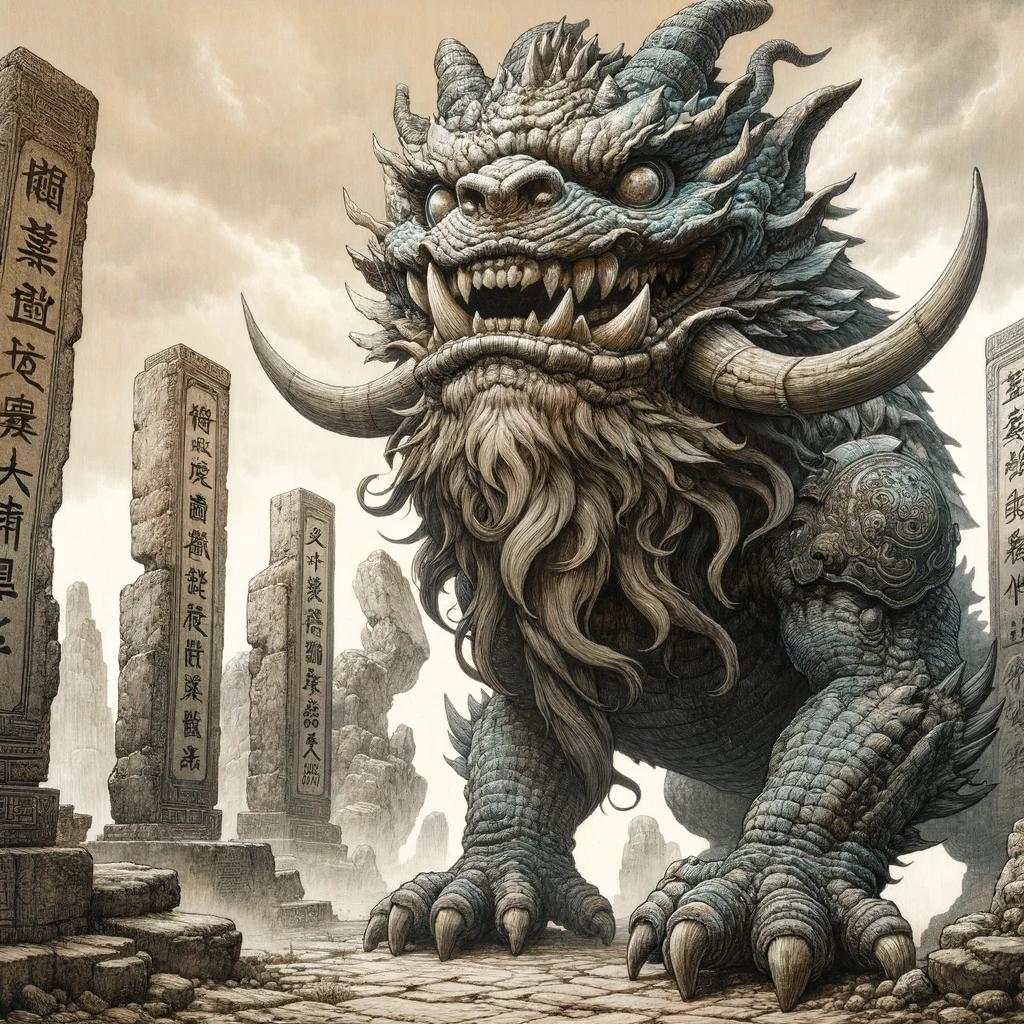Gonggong Chinese Mythology: A Mythical Tale of Chaos and Power
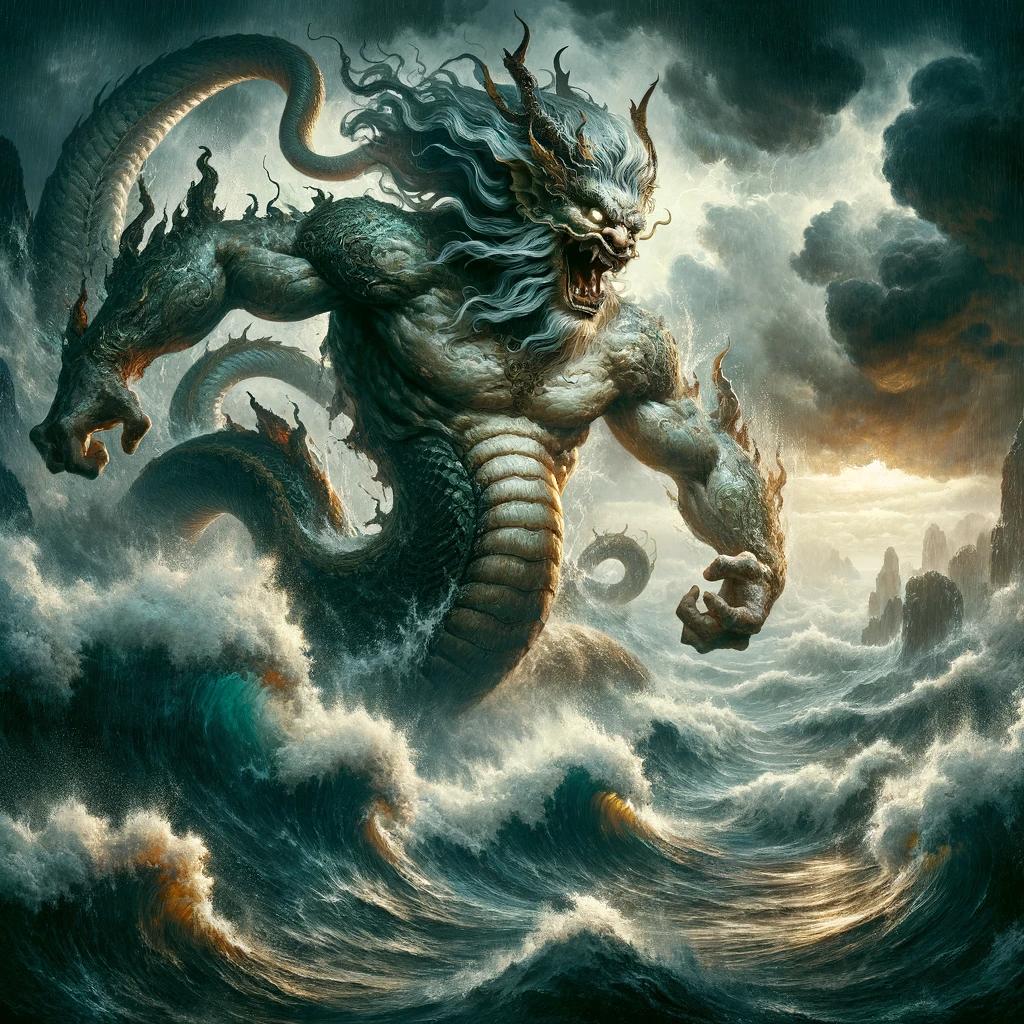
Gonggong Chinese Mythology is a captivating tale of a powerful water god in Chinese folklore. Depicted as a fearsome dragon or aquatic monster, Gonggong’s rebellion against the celestial order led to devastating consequences for the world.
In a clash with the fire god, Zhurong, the sky was broken, causing floods, fires, and the invasion of monstrous creatures. The intervention of the goddess Nuwa brought restoration, but not without altering the natural order.
Gonggong’s mythology has left a profound impact on Chinese history, literature, and contemporary culture, exploring themes of power, chaos, and the enigmatic forces of destiny.
Gonggong Chinese Mythology: A Powerful Water God
In Chinese mythology, Gonggong is a formidable and influential deity associated with water.
This section explores the origins and depictions of Gonggong, shedding light on his prominent role in Chinese mythology.
Origins and Depictions of Gonggong
Gonggong is often portrayed as a powerful water god represented by a black dragon with a human face and a horn on his head, or as a water monster with a snake-like body, human face, and red hair.
Discover the various depictions and interpretations of Gonggong throughout Chinese history and artwork.
Gonggong’s Role in Chinese Mythology
Gonggong’s significance goes beyond his physical appearance. Explore how Gonggong’s rebellious nature led to his pivotal role in Chinese mythology, where he challenged the established celestial order in a cosmic battle for control of the world.
Uncover the consequences of his actions and the enduring impact on Chinese culture and history.
Gonggong’s Rebellion: The Battle with Zhurong
Gonggong, the powerful water god, engaged in a fierce clash with Zhurong, the god of fire, unleashing a battle of epic proportions. Their conflicting forces collided in a cataclysmic struggle that shook the heavens and the earth.
The Clash of Forces: Gonggong vs. Zhurong
Gonggong, depicted as a furious black dragon or aquatic monster, confronted Zhurong, a formidable swordsman who rode upon his magical tiger. Their confrontation was a clash of elemental powers, with Gonggong relying on his immense strength and Zhurong employing his mastery of fire.
The battle between these two mighty deities raged on, each seeking to assert their dominance. Their titanic clashes reverberated across the celestial realm, unleashing chaos and devastation in their wake.
The Catastrophic Consequences of the Battle
As Gonggong and Zhurong battled ferociously, the resulting chaos led to dire consequences for the world. The heavens quaked, unleashing storms of flames and rampant floods that engulfed the land.
The breach in the sky caused unimaginable devastation, allowing otherworldly creatures to traverse into our realm, spreading hunger, horror, and seemingly endless suffering.
Despite the immense destruction caused by Gonggong’s rebellion and the catastrophic aftermath of the battle, the celestial powers and their subsequent intervention were necessary to restore order and bring about the preservation of life.
- The clash between Gonggong and Zhurong unleashed cataclysmic chaos.
- The heavens quaked, resulting in storms of flames and devastating floods.
- Otherworldly creatures emerged, spreading hunger and horror.
- The intervention of celestial forces became necessary to restore order.
The battle between Gonggong and Zhurong remains a testament to the eternal struggle between opposing forces, with far-reaching consequences that shaped the fabric of Chinese mythology.
Nuwa’s Intervention: Restoring Balance and Order
After the catastrophic battle between Gonggong and Zhurong, the goddess Nuwa emerges as the savior who strives to repair the damage caused and restore harmony to the world.
Nuwa’s Ingenious Repair of the Sky
Nuwa devises a brilliant plan to mend the rupture in the sky, utilizing a combination of resourcefulness and divine power.
She gathers rocks of five different colors and breathes her magical essence into them, infusing them with life-giving capabilities. With these multicolored stones, Nuwa painstakingly reconstructs and reinforces the celestial dome, restoring the stability of the heavens.
The Aftermath: Changes in the Natural World
However, despite Nuwa’s remarkable efforts, the repair of the sky is not flawless. As a result of the celestial fractured caused by Gonggong’s rebellion, the sun and moon now move across the sky from east to west, and the stars have been displaced from their original positions to follow the changing seasons.
Even the North Star has shifted from its true north alignment.
This shift in the celestial order mirrors the tumultuous nature of the human realm, symbolizing the enduring consequences of Gonggong’s actions.
The natural world undergoes significant transformations, reflecting the interconnectedness between the divine and mortal realms.
Through Nuwa’s intervention, a certain degree of balance and order is restored, but lingering imperfections highlight the unavoidable fluctuations and complexities within the cosmic tapestry.
The Symbolism and Influence of Gonggong
Gonggong, a prominent figure in Chinese mythology, holds significant symbolism and exerts a profound influence in various aspects, including Chinese history, literature, art, and popular culture. This section explores Gonggong’s role and impact, shedding light on its importance within Chinese society.
Gonggong in Chinese History and Literature
Gonggong’s presence can be traced back to ancient Chinese history, where it played a significant role in shaping the narrative of celestial battles and the struggle for power. Gonggong’s rebellious nature and fierce clashes with other deities symbolize the forces of chaos and disruption that every civilization faces.
Its depiction in literature, such as epic poems and historical texts, adds depth to Chinese storytelling and explores themes of conflict, order, and the consequences of defiance.
Gonggong’s Role in Shaping Historical Events
Gonggong’s tumultuous battles and control over water elements have been linked to historical events, especially those related to floods, disasters, and the formation of important waterways.
Its influence on legendary rulers, such as Emperor Shun and Yu the Great, underscores its significance within the collective memory and historical consciousness of the Chinese people.
Gonggong’s Representation in Classical Literature
Various works of classical literature incorporate Gonggong’s mythology as a source of inspiration, highlighting its impact on Chinese literary traditions.
Through iconic characters and metaphors, Gonggong’s symbolic presence adds layers of meaning and complexity, exploring themes of power struggles, destiny, and the delicate balance between order and chaos.
Cultural Significance and Legacy of Gonggong
Gonggong’s influence extends beyond historical accounts and literature, permeating the rich cultural tapestry of China.
Its symbolism and legacy are embedded in artistic expressions, rituals, and beliefs, continuing to shape the cultural identity of the Chinese people.
Artistic Representations and Iconography
Gonggong’s unique physical attributes, such as the dragon-like form with a human face or the serpent-like creature with red hair, have inspired countless artistic representations. From traditional paintings and sculptures to contemporary artwork, Gonggong’s visual depiction captures the imagination and stimulates dialogue about the forces of nature, power dynamics, and the human condition.
Festivals and Rituals
Festivals and rituals centered around Gonggong serve as a way for communities to connect with their cultural heritage and pay homage to the deity. These celebrations often involve water-related activities, emphasizing Gonggong’s association with natural elements and the cyclical patterns of life.
Popularity in Modern Culture
Gonggong’s legacy continues to resonate in modern Chinese culture, as its mythological significance finds its place in contemporary works of fiction, films, and television series. Its symbolic representation of chaos, resilience, and the human spirit captivates audiences and reflects the ongoing relevance of ancient myths in the modern world.
Overall, Gonggong’s symbolism and influence in Chinese history, literature, and culture reveal the enduring fascination with myths that explore the complexities of power, order, and the enigmatic forces that shape our world.
Unveiling the Enigmatic Order: ‘The Dream of the Red Chamber’
Exploring the Connection between Gonggong Mythology and the Classic Novel
The epic novel ‘The Dream of the Red Chamber’, written by Cao Xueqin in the 18th century, holds intriguing parallels with Gonggong Chinese mythology.
The novel’s intricate plot and complex characters capture the essence of the enigmatic order found in Gonggong’s chaotic world. Through its multi-dimensional portrayal of society, ‘The Dream of the Red Chamber’ reflects the cyclical nature of human existence, subtly mirroring the entwined fate and power struggles found in Gonggong’s mythological narrative.
As the story unfolds, the characters navigate through a maze of relationships and destiny, echoing the profound themes engrained in Gonggong’s turbulent story.
Themes of Fate, Beauty, and the Supernatural in ‘The Dream of the Red Chamber’
Within ‘The Dream of the Red Chamber’, fate plays a central role, determining the paths of the characters much like the whims of Gonggong shape the world. The novel delves into the intricate connections between beauty, fate, and the supernatural, highlighting the ethereal presence of the characters and their enchanting allure.
Images of celestial beings, magical artifacts, and otherworldly incidents abound in ‘The Dream of the Red Chamber’, reflecting the nuanced interplay between the mortal and divine realms, similar to the cosmic clash between Gonggong and the celestial powers.
As the characters traverse through joy, sorrow, and the inevitable cycle of life, their experiences mirror the chaotic yet mesmerizing world depicted in Gonggong mythology.
Gonggong Chinese Mythology in Modern Culture
Gonggong’s captivating mythology continues to have a significant impact on contemporary works of fiction, art, and popular culture.
This section explores both the influence of Gonggong in contemporary literature and his significance within Chinese art and popular culture.
Gonggong’s Impact on Contemporary Works of Fiction
Gonggong’s chaotic and powerful nature has inspired numerous contemporary writers and filmmakers to incorporate his mythology into their works of fiction. Authors and screenwriters often utilize Gonggong as a symbol of rebellion, destruction, and the struggle for power.
Through characters and storylines, contemporary works of fiction tap into the essence of Gonggong’s mythology to explore themes such as the consequences of defying order, the allure of chaos, and the eternal fight between good and evil.
These portrayals not only entertain but also invite readers and viewers to reflect on the complexities of human nature and the ever-present forces that shape our world.
Gonggong’s Significance in Chinese Art and Popular Culture
Gonggong’s symbolism and imagery have pervaded various forms of Chinese art and popular culture, leaving a lasting impression on the visual arts, music, film, and even fashion.
Artists often incorporate Gonggong’s distinct features, such as his dragon-like form or furious expression, to evoke a sense of power, unpredictability, and mystery.
In the world of music, Gonggong’s mythology has inspired compositions that aim to portray the tumultuous emotions and fierce battles depicted in his legends.
Film directors, too, have drawn from Gonggong’s story to create visually spectacular scenes that embody the elemental forces and relentless struggles that the water god represents.
Furthermore, Gonggong’s symbolism can be seen in various aspects of Chinese popular culture, from merchandise featuring his iconic image to the incorporation of his story as a theme in festivals and celebrations.
His presence serves as a reminder of the enduring fascination with mythological figures and the cultural heritage they represent.
In Summary
As we delve into modern culture, Gonggong’s mythology remains a fertile source of inspiration for contemporary works of fiction and artistic expressions. From captivating novels to visually stunning films, his legacy continues to captivate audiences, igniting their imagination and inviting contemplation about the profound themes embedded within his timeless tales.
The Enduring Lessons and Fascination with Gonggong
In the realm of Chinese mythology, Gonggong continues to captivate and intrigue through the profound philosophical and moral themes embedded within his story. Delving deep into the lessons and enduring fascination surrounding Gonggong’s mythology offers profound insights into the dynamics of power, chaos, and the human condition.
The Profound Philosophical and Moral Themes of Gonggong Mythology
Gonggong’s mythology presents a rich tapestry of philosophical and moral themes that resonate with audiences to this day. One such theme is the consequences of unchecked power. Gonggong’s rebellion against the celestial order serves as a cautionary tale, warning against the dangers of allowing one’s desires and frustrations to spiral out of control, leading to catastrophic outcomes.
- The struggle between order and chaos: Gonggong’s defiance highlights the eternal conflict between order and chaos, exploring the delicate balance that governs the universe.
- The burden of hierarchy: Gonggong’s dissatisfaction with his menial tasks in the heavenly courts sheds light on the challenges and frustrations that arise from rigid hierarchical structures.
- The pursuit of personal fulfillment: Gonggong’s rebellion raises questions about the quest for personal fulfillment and the consequences of seeking individual desires at the expense of wider harmony.
- The resilience of the human spirit: Despite the immense suffering caused by Gonggong’s actions, humanity perseveres, demonstrating the innate ability to overcome adversity.
Gonggong’s Relevance in Understanding the Dynamics of Power and Chaos
Gonggong’s mythology provides a profound lens through which to examine the intricate dynamics of power and chaos, allowing us to grasp the complexities of their interplay in the world.
- The allure and dangers of power: Gonggong’s immense strength and influence illustrate the seductive nature of power, as well as the potential for it to be wielded irresponsibly, leading to widespread devastation.
- The destructive force of chaos: Gonggong’s rebellion and the ensuing disruptions reveal the destructive potential of chaos, highlighting the need for balance and order in society.
- The necessity of finding equilibrium: By examining the consequences of Gonggong’s discord, we are reminded of the importance of striving for equilibrium, both individually and collectively, to maintain harmony and stability.
- The eternal struggle for balance: Gonggong’s ongoing presence in Chinese culture serves as a reminder that the struggle between power and chaos is a perpetual battle, requiring vigilance and introspection to navigate.
Gonggong’s enduring lessons and the fascination surrounding his mythology provide a window into the complexities of the human experience, urging us to contemplate the consequences of our actions, the dynamics of power, and the delicate balance that exists within the world.
As we continue to delve into Gonggong’s story, we uncover deeper insights into the human condition and the eternal quest for equilibrium.
.











